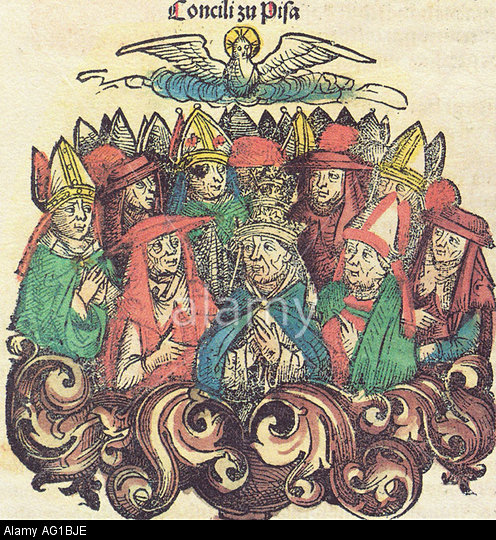08: From Schism to the Renaissance Papacy
Urban VI (1378-89)
- Bartolomeo Prignano, Archbishop of Bari; monk; not in College of Cardinals
- Clashes: second meeting of College of Cardinals at Anagni: elect Robert of Geneva as Clement VII 1378-94
- Urban: names 25 new cardinals
- Regional politics: Giovanna of Naples (d. 1382) recognizes Clement; Urban names Charles of Durazzo instead
- Urban and Charles then break alliance
Urbano VI at Nocera, from Croniche of Giovanni Sercambi
Boniface IX (1389-1404)
- 2 jubilees 1390, 1400
- International support for Rome vs Avignon splits along regional political lines
- Rome: Italian cities, England, Ireland, E. Europe, Scandinavia, Flanders
- Avignon: France, Spain, Naples & Sicily, Scotland
- HRE vacillates
Conciliar Movement
1409 Council of Pisa

- deposes both popes (Gregory XII Rome, Benedict XIII Avignon)
- Names new pope: Alexander V, then John XXIII; but fails to achieve consensus
1414-18 Council of Constance
Council of Constance, 1414-18, illustration from Chronicle of Ulrich von Richenthal
1417-31 Martin V (Oddone Colonna)
Other issues: Jan Hus
Rome: a long reboot
Rome ca. 1469 BAV Vat. lat. 5699 – fol-127r
Issues:
- Papal power versus councils
- Church administration
- City Government
- Papal states and a peninsula full of chronic warfare
Martin V (Oddone Colonna) (pope 1417- 1431)
- In Florence until 1420
- Brother in control of Rome in meantime
- International problems: Hussite wars
- Rome
- Biggest old noble families: out of main city government positions 1360s+ but still powerful
- New elites
- Physical plant:
- Lack of maintenance
- 1348 earthquake
- 1413 sack by Naples
- Lateran; Vatican
- Santa Maria Maggiore
- Santi Apostoli
- Many agreements of 1360s fallen into abeyance during schism
- 1425 renews 1363 statutes but pope chooses most government officials
- Assisted by brother
- Promoted Colonna clients, weakened other families:
- appointments in curia
- city jobs
- papal familia (household)
- Senator; papal Vice-Chamberlain
Growth of new nobles/elites
Magistrate of Streets and Buildings
Eugenius IV (Gabriele Condulmer, Venetian) (1431-47)
Troubles in Rome
Anti-Colonna moves
1434 to Florence (9 years) with Medici support
Giovanni Vitelleschi commander of papal army: condottiere and cardinal
1446 concordat with city; restored some but not all 1363 statutes
Continuing wars with Milan
Council and Curia: main source of difficulty
Obliged to meet every 5 years
Council of Basel (then Ferrara-Florence) 1431-39
Eugenius dissolved, moved it to Ferrara (1438)
Basel prelates objected, declared Eugenius heretic and therefore deposed
Named own candidate: Felix V, 1439-49
Council moved to Florence
Plague in Ferrara
Cosimo de’ Medici offered to cover costs
Temporary end to East-West Schism; support pledged to Constantinople
Pisanello, sketches of John VIII Palaeologus
Pisanello, medal of John VIII (National Gallery of Art, Washington)
Other regional church agreements as well
Recognizes Alfonso V of Aragon as King of Naples
1443 Eugenius returns to Rome
Continues with religious reforms begun earlier
(1431 had re-opened university)

Isaia da Pisa, Tomb of Eugenius IV S. Salvatore in Lauro, Rome (formerly Old St. Peter’s)
Foundations for future development
Masaccio and Masolino, Santa Maria Maggiore Altarpiece (ca. 1428-9)





